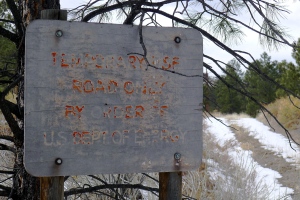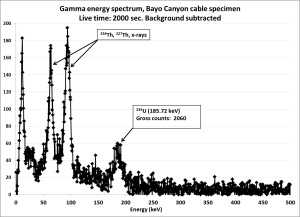 I’ve written about this place twice before, and a bumper crop of radioactive souvenirs from a February visit compels my new assessment that Bayo Canyon, New Mexico is simply unmissable for any hardcore nuclear tourist.
I’ve written about this place twice before, and a bumper crop of radioactive souvenirs from a February visit compels my new assessment that Bayo Canyon, New Mexico is simply unmissable for any hardcore nuclear tourist.  Of course, there’s the historical dimension: the radiolanthanum experiments that commenced here in 1944 provided crucial insight into the implosion weapon design validated in 1945 by the Trinity test (and embodied later by “Fat Man” and virtually all successive bombs).
Of course, there’s the historical dimension: the radiolanthanum experiments that commenced here in 1944 provided crucial insight into the implosion weapon design validated in 1945 by the Trinity test (and embodied later by “Fat Man” and virtually all successive bombs).  But what makes Bayo so special is that the history here is tangible, collectable, and detectable provided you come with a Geiger counter.
But what makes Bayo so special is that the history here is tangible, collectable, and detectable provided you come with a Geiger counter.
.
.
.
.
 The next four photos at left show pieces of blast debris that were scattered across the surface near the escarpment under Point Weather (where I am standing, 2nd photo above), along with readings in counts per minute on a Ludlum 44-9 pancake GM tube.
The next four photos at left show pieces of blast debris that were scattered across the surface near the escarpment under Point Weather (where I am standing, 2nd photo above), along with readings in counts per minute on a Ludlum 44-9 pancake GM tube.  While the great majority of findings are not detectably hot, there is so much debris available that the prospects for major finds here are good.
While the great majority of findings are not detectably hot, there is so much debris available that the prospects for major finds here are good.  This is my second piece of radioactive cable, and the other two pieces appear to be aluminum metal. For comparison, local background is about 60 CPM.
This is my second piece of radioactive cable, and the other two pieces appear to be aluminum metal. For comparison, local background is about 60 CPM.
.
.
.
.
.
 There is sufficient gamma radiation to identify uranium in one of these samples by scintillation spectrometry and to estimate its present activity. The piece of cable was my choice for this test, owing to easy source-detector geometry and negligible self-absorption. The last image is the 2000-second NaI:Tl gamma energy spectrum. The peaks are consistent with the prominent decay radiation of U-235 at 185.72 keV (emitted in 57.2% of decays). Assuming a geometric efficiency of ~50% and an intrinsic photopeak efficiency of ~75%, the piece of cable contains about 8 mg of uranium if the uranium has its natural isotopic ratio, or about 20 mg if it is depleted. (Both DU and natural U were used in the Bayo experiments.)
There is sufficient gamma radiation to identify uranium in one of these samples by scintillation spectrometry and to estimate its present activity. The piece of cable was my choice for this test, owing to easy source-detector geometry and negligible self-absorption. The last image is the 2000-second NaI:Tl gamma energy spectrum. The peaks are consistent with the prominent decay radiation of U-235 at 185.72 keV (emitted in 57.2% of decays). Assuming a geometric efficiency of ~50% and an intrinsic photopeak efficiency of ~75%, the piece of cable contains about 8 mg of uranium if the uranium has its natural isotopic ratio, or about 20 mg if it is depleted. (Both DU and natural U were used in the Bayo experiments.)

